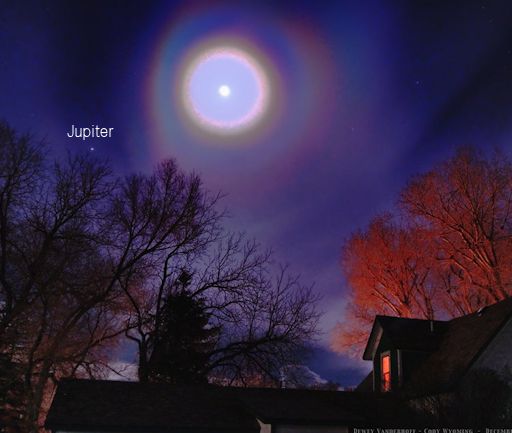When is the best time to see auroras? Where is the best place to go? And how do you photograph them? These questions and more are answered in a new book, Northern Lights - a Guide, by Pal Brekke & Fredrik Broms. | | |
EDGE OF SPACE CHRISTMAS CARDS: What do you give to the sky watcher who has everything? How about a Christmas card from the Edge of Space? For only $49.95, the students of Earth to Sky Calculus will fly your holiday greeting or favorite picture to the top of Earth's atmosphere, photograph it, and return the snapshot in time for the holidays. It's a unique gift! The group has previously flown cupcakes, shoes, US presidents, ad banners and telescopes. This holiday magic is performed using suborbital helium balloons. Contact Dr. Tony Phillips for more information.
BRIGHT LIGHTS IN THE NIGHT SKY: When the sun goes down tonight, step outside and face east. Jupiter and the Moon are having a close encounter in the constellation Gemini, only 5 degrees apart. Dewey Vanderhoff photographed the pair converging on Dec. 17th over downtown Cody, Wyoming:

In Vanderhoff's image, the Moon is surrounded by a colorful lunar corona, caused by the diffracting action of water droplets and ice crystals in high clouds. "This was the most magnificent display of rainbow-colored clouds that I have ever seen," says Venderhoff. "A huge swath of cirrus clouds passed in front of the Moon, producing brilliant colors in several concentric bands. The bands undulated as the clouds moved across the face of the moon, propelled by strong upper level wind currents. I took multiple exposures and combined three frames using an HDR technique in Photoshop to capture and display the widest possible tonal range and color subtlety."
The Moon and Jupiter are two of the three brightest objects in the night sky. (Venus is the other.) As a result, this conjunction is visible even from brightly-lit cities. Take a look. It's a beautiful way to end the day. [sky map]
Realtime Space Weather Photo Gallery
THE LONG TAIL OF COMET LOVEJOY: Next week, Comet Lovejoy makes its closest approach to the sun. The comet's tail is already amazing. Scroll down this image taken by Gerald Rhemann of Jauerling, Austria, for more information:

Filled with knots and eddies of dusty plasma, Lovejoy's tails stretches more than 20 degrees across the sky--long enough to overlap 40 full Moons or fill the Bowl of the Big Dipper twice. At closest approach to the sun or "perihelion" on Dec. 23rd, the comet will be just inside the orbit of Earth (0.82 AU). The extra heating it gets at perihelion will grow the tail even more.
Comet Lovejoy shines like a 4th magnitude star so it is barely visible to the unaided eye (especialy when the sky is filled with full moonlight). However, for backyard telescopes, the comet is a fairly easy target rising ahead of the sun in the eastern morning sky. If you have a GOTO telescope, send it to these coordinates. Slight pointing errors are no problem, because the tail is almost too broad to miss. Sky maps: Dec. 18, 19, 20. Backyard astronomy alerts: text, voice
Realtime Space Weather Photo Gallery
EDGE OF SPACE CHRISTMAS CARDS: What do you give to the sky watcher who has everything? How about a Christmas card from the Edge of Space? For only $49.95, the students of Earth to Sky Calculus will fly your holiday greeting or favorite picture to the top of Earth's atmosphere, photograph it, and return the snapshot in time for the holidays. It's a unique gift! The group has previously flown cupcakes, shoes, US presidents, ad banners and telescopes. This holiday magic is performed using suborbital helium balloons. Contact Dr. Tony Phillips for more information.
Realtime Aurora Photo Gallery
Realtime Comet Photo Gallery
Every night, a network of NASA all-sky cameras scans the skies above the United States for meteoritic fireballs. Automated software maintained by NASA's Meteoroid Environment Office calculates their orbits, velocity, penetration depth in Earth's atmosphere and many other characteristics. Daily results are presented here on Spaceweather.com.
On Dec. 18, 2013, the network reported 12 fireballs.
(10 sporadics, 1 sigma Hydrid, 1 December Leonis Minorid)

In this diagram of the inner solar system, all of the fireball orbits intersect at a single point--Earth. The orbits are color-coded by velocity, from slow (red) to fast (blue). [Larger image] [movies]
Potentially Hazardous Asteroids (
PHAs) are space rocks larger than approximately 100m that can come closer to Earth than 0.05 AU. None of the known PHAs is on a collision course with our planet, although astronomers are finding
new ones all the time.
On December 18, 2013 there were 1446 potentially hazardous asteroids.
Notes: LD means "Lunar Distance." 1 LD = 384,401 km, the distance between Earth and the Moon. 1 LD also equals 0.00256 AU. MAG is the visual magnitude of the asteroid on the date of closest approach. | | The official U.S. government space weather bureau |
| | The first place to look for information about sundogs, pillars, rainbows and related phenomena. |
| | Researchers call it a "Hubble for the sun." SDO is the most advanced solar observatory ever. |
| | 3D views of the sun from NASA's Solar and Terrestrial Relations Observatory |
| | Realtime and archival images of the Sun from SOHO. |
| | from the NOAA Space Environment Center |
| | the underlying science of space weather |

